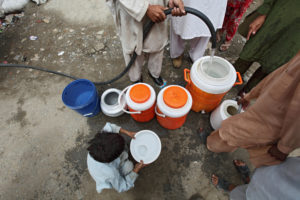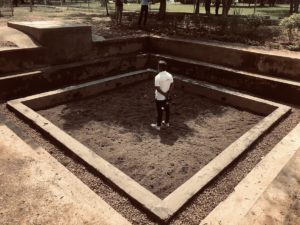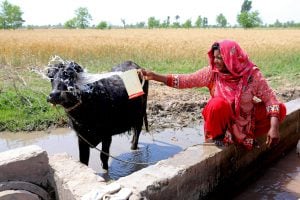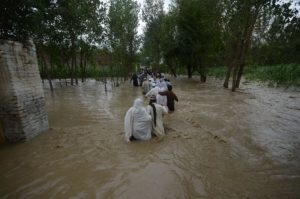Takht-e-Nasrati in northern Pakistan was once known for its lush greenery. But over the past 10 years local people say life has become very different in this area of Karak district, in Khyber Pakhtunkhwa. Tubewells have dried up, forcing residents to dig deeper in search of freshwater. “This [year] we found water at a depth of 225 metres,” said Sarmad Khattak, a local resident. His 1.6 hectares of land have been barren since 2013, with rains erratic and insufficient while wells have run dry.
Groundwater across Pakistan’s northwestern province is being used at an unsustainable rate, government officials have said.
“Groundwater depletion is happening throughout Khyber Pakhtunkhwa. However, it is severe in southern districts,” said Irfan Rasheed, chief engineer at the provincial government’s Public Health Engineering Department.
Afsar Khan, the deputy director of the climate change unit within Khyber Pakhtunkhwa’s Environmental Protection Agency (EPA), echoed Rasheed’s sentiments, stating that the water found below the earth’s surface is often too saline to drink now, with freshwater too deep to extract. In 2014, Khan said, the provincial government declared five districts out of 34 – Dir Lower, Dera Ismail Khan, Karak, Lakki Marwat and Tank – as hotspots of drinking water scarcity. Four of these are in the south of the province.
The last comprehensive study of Khyber Pakhtunkhwa’s groundwater was in 1988, when the province was still called the North-West Frontier Province and the area previously known as the Federally Administered Tribal Areas had not been incorporated into it. No further comprehensive study has been undertaken since.
The Third Pole requested data on groundwater levels, locations and extraction rates from the nine government departments in Khyber Pakhtunkhwa that deal with water extraction and management, from the provincial to the district level. All said they lacked data on how fast the water table is dropping, citing a lack of funds and equipment.
Irregular urbanisation, centuries-old irrigation methods and non-implementation of policies are taking a toll on groundwater tableYasin Wazir, director-general for soil and water conservation in Khyber Pakhtunkhwa,
Despite a lack of comprehensive data, recent district-level announcements indicate the scale of the problem:
- An appeal to the public in Swat to reduce water use was made in June this year. Speaking at a press conference Shaida Muhammad Khan, head of Water and Sanitation Services Company Swat (a public sector company that manages water in Swat), stated that the northern district faces dropping groundwater due to drought and high temperatures.
- A similar appeal was also issued by Bajaur’s District Water Management Department in June.
- A 2019 study by the Pakistan Council of Research in Water Resources (PCRWR) found that over the previous four to five years, the water table in Mohmand and Khyber districts had dropped by more than 60 metres.
Citing reports by the Pakistan Meteorological Department, as Khyber Pakhtunkhwa’s EPA has no weather-monitoring stations and records of its own, Khan said that extreme heatwaves and droughts have led to increased water extraction and depletion of the water table.
In theory, Khyber Pakhtunkhwa is water-abundant
On paper, Khyber Pakhtunkhwa has abundant water resources other than groundwater, such as surface water. Under the 1991 Water Apportionment Accord, the province was allocated 8.78 million acre-feet (MAF) of the waters of the Indus River. But according to the provincial government, a lack of infrastructure to transport water to where it is needed means Khyber Pakhtunkhwa underutilises its allocation, using less than 6 MAF. As a result, people access water from tubewells, pumping out groundwater. The province extracts 4.2 MAF of groundwater a year for irrigation and domestic purposes, according to Khyber Pakhtunkhwa’s Planning and Development Department.
“Groundwater is extracted for irrigation throughout the world, but they know the potential of the resource and have strategies to recharge aquifers that we lack,” said Mehboob Alam, a hydrologist who is general manager projects for water and sanitation services in Peshawar, the capital of Khyber Pakhtunkhwa. Alam said scientific mapping, using both satellite and ground-based data, is urgently needed to reverse the groundwater crisis.
“We extract far more [groundwater] than we need,” said Yasin Wazir, director-general for soil and water conservation in Khyber Pakhtunkhwa, describing how “irregular urbanisation, centuries-old irrigation methods and non-implementation of policies are taking a toll on groundwater table”.
Solar-powered tubewells intensify groundwater extraction
In 2019, the Ministry of National Food Security and Research approved the solarisation of 700 tubewells, among other initiatives such as building ponds and building watersheds. While the latter can help to recharge groundwater, solar-powered pumps have made it cheaper to extract more groundwater.
Now, in response to rising energy costs, the number of solar-powered pumps is likely to grow. There are plans to solarise 30,000 grid-connected tubewells across the country, officials at the Planning and Development Department told The Third Pole. In addition, experts told The Third Pole, there is no federal and provincial-level policy to regulate new tubewells in consideration of groundwater shortage and other environmental concerns.
“A 12.5 horsepower solar tubewell extracts 35,000 gallons of water per day, which is 1.5 cusecs per month. It is alarming enough when compared to the recharge rate,” said Dr Shahid Iqbal, a regional researcher on water modelling at non-profit research organisation the International Water Management Institute.
Mohammad Akmal, an agronomist at the University of Agriculture in Peshawar, pointed out that the real concern around solarised tubewells is the lack of regulation. “In the absence of policy and modern irrigation techniques, these [solar-powered] tubewells would extract water all day long, as the existing ones have been doing, and take an immense toll on the already stressed resource,” he said.
Unplanned migration has hit Peshawar’s groundwater hard
Experts from the Public Health Engineering Department, municipalities, and water and sanitation companies stressed to The Third Pole that agriculture is the major user of water in Khyber Pakhtunkhwa, as in much of South Asia. However, they said, the province’s growing population and urbanisation are also significant causes of groundwater depletion in cities.
Khyber Pakhtunkhwa has a high total fertility rate. At 4.0 as of 2017, it remains much higher than the replacement rate of 2.1, and is significantly higher than Pakistan’s overall fertility rate of 3.4. The government has pointed out that this means increased demand for water.
15 metres
Drop in water table across Peshawar district over 30 years
With greater opportunities in urban areas, Khyber Pakhtunkhwa has seen high levels of rural-to-urban migration. The capital Peshawar has grown from just under 1 million people in 1998 to 2.3 million in 2017, with the population density increasing seven-fold between 1972 and 2017 – from about 218 people per square kilometre to about 1,566 people.
The Khyber Pakhtunkhwa Water Act in 2020 banned private wells to protect the water table, but with Peshawar dependent on groundwater and the law not enforced, they are commonly used – in addition to the Peshawar district’s 1,400 public tubewells. Researchers have found that across the Peshawar district the water table has dropped by 15 metres in 30 years.
“We lack climate-resilient planning and infrastructure,” said Wazir, the director-general for soil and water conservation.
Khyber Pakhtunkhwa authorities wake up to situation
In April 2018, Pakistan passed its first National Water Policy. The federal government called the water crisis a “thunderbolt” and asked the provinces to take steps to properly manage their resources. In response, in 2020, the Khyber Pakhtunkhwa government brought in water and climate change policies and passed the Water Act.
Under the Act, the provincial government established a Water Resources Commission. A Water Resources Regulatory Authority was due to be formed within six months, but there is still no sign of it and no reason has been given for the delay. The provincial government also devised an Integrated Water Resource Management (IWRM) strategy in 2021 for better management of groundwater.
Then on 22 July this year, the Directorate of Soil Conservation signed an agreement with the Pakistan Council of Research in Water Resources (PCRWR) that aims to prevent the groundwater crisis from spiralling out of control.
“PCRWR will identify spots where the water table is declining and construct ponds where rainwater will be diverted through pipelines to improve the table,” said Muhammad Irfan, the deputy director of planning at the Directorate of Soil Conservation. The IWRM report found that nearly all the groundwater extracted in a year for irrigation and domestic purposes could met through rainwater harvesting
PCRWR will also provide training to Directorate of Soil Conservation staff on preventing groundwater contamination and controlling salinity.









